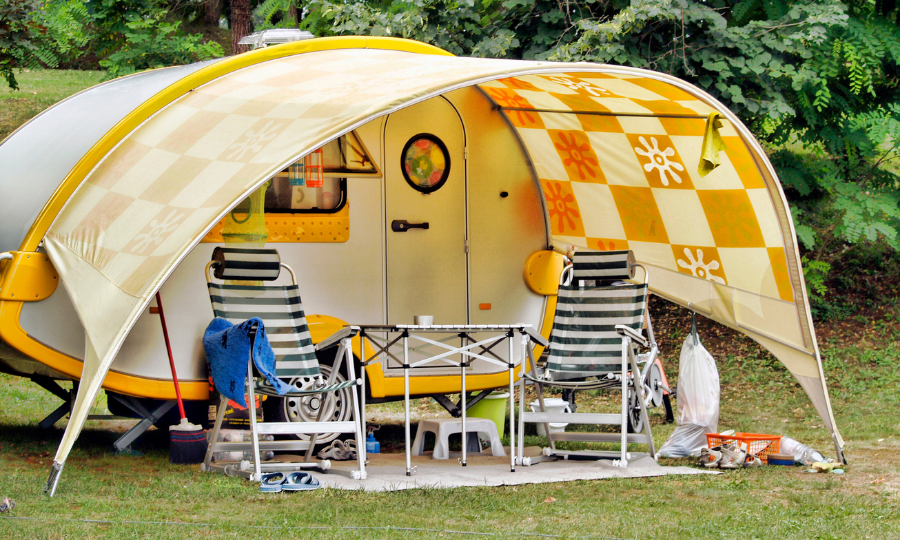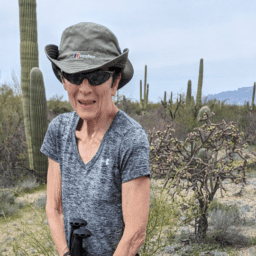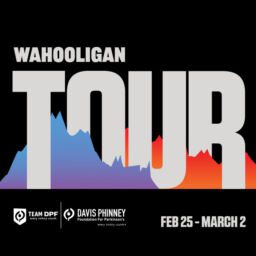In this episode of “Camping With Parkinson’s,” our guides Marty Acevedo and Carol Clupny explain the types of camping and campers, their best tips on where to stay, and extra safety considerations you’ll be happy to know when you’re on the road.
episode 1: Types of campers, types of camping, and what to pack
tips and tricks mentioned
Types of Campers:
 Truck Camper
Truck Camper
- A camper that attaches to the bed of a truck
- Camper Van
- Also referred to as Class B Motorhome (more on that below)
- Trailers
- Trailers hook onto a hitch of a large vehicle (aka “Expandable Travel Trailer”)
- Trailers are often cheaper than RVs
- Toy Haulers
- RVs that have a dedicated space to haul toys such as golf carts, kayaks, dirt bikes
- Toy Haulers often have a small kitchen or pop out bed included
- 5th Wheels
- 5th Wheels attach to a truck bed and are one of the larger and more expensive options
- RVs class A, B, and C
- An RV is short for Recreational Vehicle, or in other words, a “home on wheels”
- Class A:
- Class As look like buses with flat fronts, have the most storage, and are the best for full time living
- Class B:
- Class Bs are also known as “Camper Vans” and are the smallest of all three types of RVs
- Class C:
- Class Cs are medium size, often have a bunk over the driver’s seat, and tend to be the most affordable
RV Tips:
#1 – Try renting an RV before purchasing. That way you can be certain of what kind you like best before investing.
#2 – Some companies will deliver an RV right to your campsite, so you can enjoy RV camping without all the hassle.
Where To Stay
- Established Campgrounds in Parks
- National Parks
- State Parks
- County Parks: Each state will have its own website/list of county parks. A basic internet search of your destination “state” and “county parks” will easily yield information
- City Parks
- Boondocking (also known as dispersed camping)
- Boondocking means camping outside of a designated campground on public land. This does not mean you can camp anywhere you see an open field! Follow the detailed guide below to discover areas of public land that are open to boondocking. Note that depending on the location, the dispersed camping area may be completely wild or have some established camping sites. If there are established sites, it is best practice to use them, as they have been created to protect surrounding wildlife
- The National Forest Service
- Select the national forest you wish to camp in
- Choose recreation -> camping and cabins
- Select “dispersed camping”
- The Bureau of Land Management
- To learn more about dispersed camping on BLM lands, click here. You may find it easiest to go this BLM interactive map to look for dispersed camping areas
- The National Forest Service
- Boondocking means camping outside of a designated campground on public land. This does not mean you can camp anywhere you see an open field! Follow the detailed guide below to discover areas of public land that are open to boondocking. Note that depending on the location, the dispersed camping area may be completely wild or have some established camping sites. If there are established sites, it is best practice to use them, as they have been created to protect surrounding wildlife
- Harvest Hosts
- Harvest hosts is a membership program that offers unique sites for RVs to stay at for free. Since these are usually places of business (i.e., wineries, breweries, museums) the expected courtesy is to spend money on the services at the site
- Store Parking Lots
- There are a few store parking lots that will allow you to park your vehicle for free overnight. These include:
- Cracker Barrel
- Cabela’s
- Walmart
- When parking overnight in a store parking lot, it is best practice to let the manager know and purchase something in the store to support their business
- There are a few store parking lots that will allow you to park your vehicle for free overnight. These include:
- Other helpful websites to find campsites
Packing
- Marty and Carol’s Comprehensive Packing List
- Space-saving entertainment
- Sketchpad and pens
- Cards and dice
- Cross stitching
- Ping pong paddles
- Kindle for reading
- Apps on phone (Marty likes Brain Games)
Safety Considerations
- Trekking poles or a cane/walking stick
- Check for a working fire extinguisher
- Adequate lighting inside and outside the vehicle
- Basic toolbox for essential fixes on your vehicle
- Physical maps in case GPS doesn’t work
get inspired
Check out some of the unique places, things, and adventures Marty and her husband, Ace Acevedo, have discovered thus far in their camper-van travels.


continue watching
Continue watching this series and learn from Marty and Carol about cognition and camping, how to manage symptoms while camping, nutrition and exercise, and medication and deep brain stimulation (DBS) tips for camping adventures.
Get connected
Email blog@dpf.org with your best camping stories or tips and tricks you would like to share with the Parkinson’s community. Interested in getting in touch with Marty and Carol? You can reach out to them personally by visiting Marty’s Ambassador page or Carol’s Ambassador page.




















